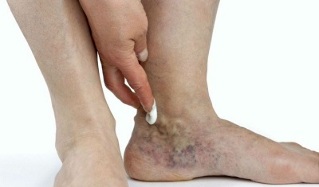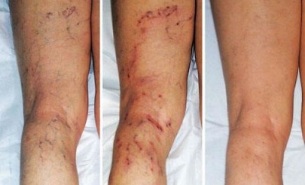
Varicose veins are one of the diseases that it is not clear who exactly to choose as a victim, because both young and old can suffer from it.
Few rush to doctors after the development of the disease, not thinking that it is much easier to get rid of the problem in the early stages.
To seek help right away, you should know what varicose veins on the legs look like, symptoms and treatment, the photo will also help identify the disease and respond immediately.
What are the symptoms of varicose veins in the legs
It is believed that only women are usually worried about varicose veins on the legs, while the symptoms are inherent in both men and the fair sex, because they are almost the same. You shouldn't wait for the disease to begin to progress, so you should contact your doctor as soon as the first signs of an insidious disease appear.
What symptoms of varicose veins in the legs should be alarming? There aren't that many:
- venous patterns that appear on the legs, thighs;
- feeling of fullness and heaviness in the lower limbs;
- night cramps (often occurring during the day);
- swelling appears after a hard day's work;
- fatigue increases sharply;
- there is discomfort in the legs.
Even a single alarm signal is enough to send medical assistance immediately, the sooner it is done, the greater the chances of treatment success.
Varicose veins in the legs, symptoms during pregnancy
Problems with the veins of the lower extremities often appear in women who are in an interesting position, because there is an additional load on the legs. There is a significant difficulty here: the treatment should not harm the fetus, so you should not try to overcome the disease on your own. Only a doctor can accurately diagnose the disease and prescribe the safest treatment option for the child.
If the presence of varicose veins in the legs is suspected, the symptoms during pregnancy differ little from the more common signs of the disease. These include:
- small "stars" that appear on the legs;
- unpleasant discomfort that is felt in the lower limbs not only in the evening, but during the day;
- severe swelling which can form not only in the lower legs, but also in the thighs themselves;
- pain and soreness when walking;
- changes in the skin (peeling, appearance of age spots, change in natural shade);
- veins begin to protrude above the skin, severe pain appears when pressed.
Although there is no certainty that it is precisely varicose veins on the legs, the symptoms must certainly be indicated to the doctor: only a specialist can accurately diagnose the disease and determine the degree of its development.
Symptoms of internal varicose veins in the legs
According to doctors, internal varicose veins can lead to serious complications, so it's especially important to recognize them in time. This also does not guarantee that the treatment will be successful.
Symptoms of internal varicose veins in the legs:
- sharp or dull pain in the lower limbs;
- heaviness and burning that hardly stops;
- seals are visible on the skin;
- red or blue "stars" appear;
- the veins under the skin expand, in some places they resemble grapes;
- looks like wounds that practically do not heal, possibly even the development of gangrene, this can lead to the loss of a limb.
The most dangerous phase is when the muscles and bone mass begin to deform. If left untreated, this can be fatal.
Varicose veins in the legs, symptoms
No less life-threatening are varicose veins of the deep veins of the legs, the symptoms of which are not as pronounced as in a common disease. How to independently determine the presence of a serious disease?

There are many signs of the disease and almost all of them can be detected independently if you know what to look for:
- discomfort in the lower limbs (burning, heaviness, aching pain);
- the skin becomes dry, scaly areas may appear;
- convulsions appear at night, which can last until morning;
- saphenous veins expand, increasing in diameter several times;
- there are numerous small wounds that do not respond to treatment and do not heal.
Without immediate treatment, ulcers and eczema may soon develop, followed by gangrene. Blood clot formation resulting in death is also possible.
Which doctor should I contact if I have symptoms of varicose veins
Even if the dangerous signs were identified in a timely manner, patients do not rush to the hospital, not knowing which doctor to contact if symptoms of varicose veins are detected. There are no options here - only a doctor is able to stop the development of the disease. An immediate visit to a phlebologist significantly reduces the risk of complications.
If you go to the doctor late, it is possible that the ailment spreads to the lower limbs, so you will not be able to do this with the help of a phlebologist. If the specialist deems it necessary, he can turn to colleagues.
Among the specialists who will help in the treatment of varicose veins are:
- cardiac surgeon;
- angiosurgeon (specialized in the treatment of surgical diseases);
- physiotherapist;
- dermatologist.
A multi-specialist treatment can take many months or even years. If the phlebologist cannot cope with the disease on his own, this indicates that he has already passed the initial stage.
Treatment with ointments: which drugs to use to effectively get rid of the disease
At home, treatment with ointments is most often prescribed, but only if there are no complications or contraindications. It is better not to use such drugs alone, it is imperative to agree with a doctor first on the course of action on the disease.
Treatment of varicose veins with folk remedies
In the initial stages of the disease, you can practice treatment with folk remedies, but only with the permission of the doctor. The most effective here are compresses and rubbing, which you can prepare yourself from plant materials.
Green walnuts have proven themselves in the fight against varicose veins. Grind about a glass of unripe fruit, pour olive oil in equal parts. Insist fragrant liquid for about a month and a half. Next, use as a rub, massaging a small amount of oily liquid into the affected areas daily.
You can also use the horse chestnut infusion, which acts locally. To prepare the medicine, you will need the inflorescences and leaves of the plant. Grind them, pour high-quality vodka or alcohol (based on one part of plant materials, 6-8 parts of alcohol). Insist a week, rub into the skin of the legs before bedtime.
Consequences of varicose veins on the legs
Knowing what consequences of varicose veins on the legs threaten your health will help you start treatment faster. The disease can progress at an astonishing rate without treatment and end in thromboembolism. At best, this will lead to disability, but statistics show that in nearly one third of patients the disease ends in death.
Trophic ulcers may appear, which are practically not subject to treatment. The size and depth of the lesions can increase and soon spread to large areas of the lower limbs. This inevitably leads to gangrene. Even if treatment is used, therapy can be prolonged for a long time and with no guarantee of success.
Varicose veins on the legs, symptoms and treatment, photos and consequences - all this information can be studied on your own to prevent a dangerous ailment. It should not be hoped that it will be possible to avoid it by midnight, but even timely treatment will be enough to not worry about the consequences or complications.




































